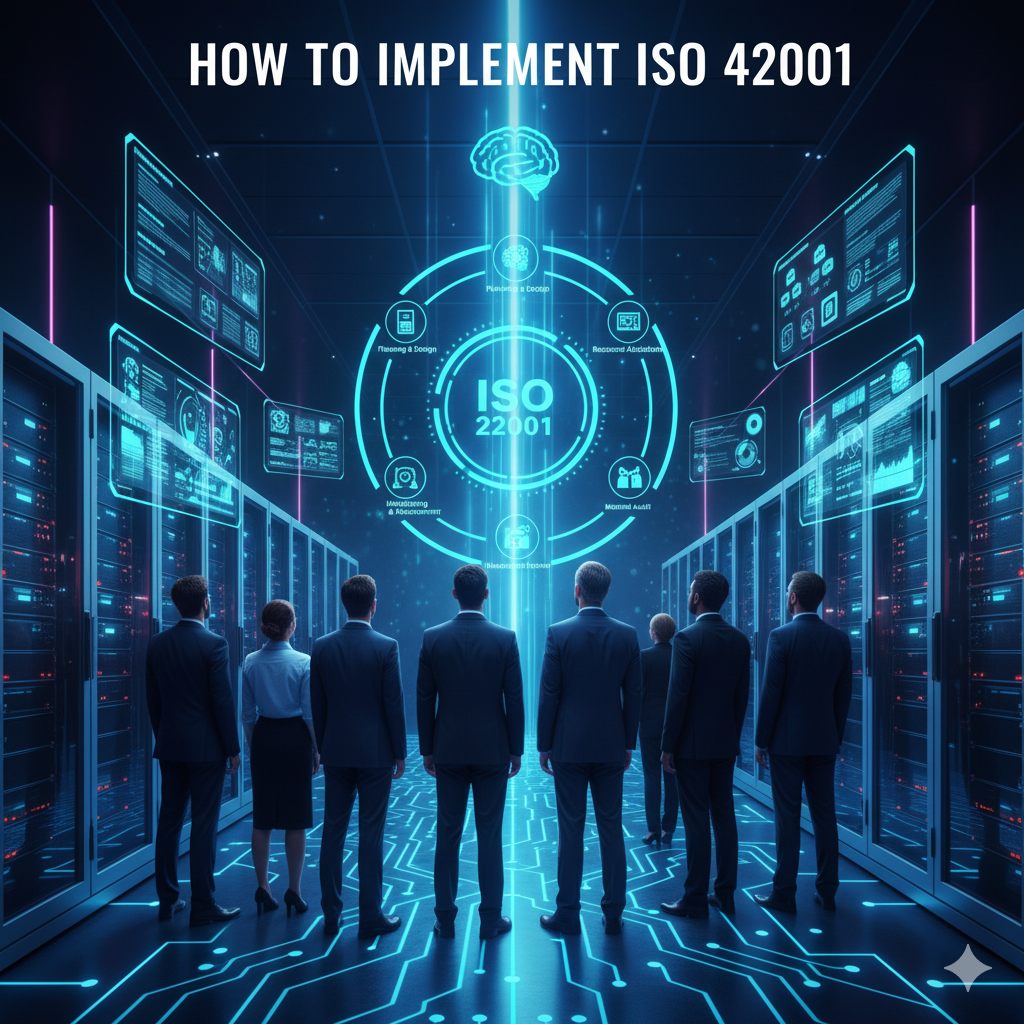AI governance tools are software platforms that help organizations manage, monitor, and control artificial intelligence systems to ensure ethical, compliant, and secure operations. These platforms address risks like model bias, data privacy violations, and regulatory non-compliance that can emerge from AI deployments.
The AI governance software market has grown from approximately $227 million in 2024 to a projected $4.83 billion by 2034, according to Knostic AI research. This growth reflects increasing enterprise adoption of AI systems and corresponding regulatory requirements.
Chief Information Security Officers now face the challenge of implementing governance frameworks that balance innovation with risk management. Recent industry analysis shows that 78% of security executives have increased their generative AI investments, yet many lack comprehensive governance capabilities.
Modern enterprises typically operate diverse AI portfolios that include internally developed models, third-party vendor solutions, and embedded AI capabilities within existing applications. Without proper governance tools, organizations struggle to maintain visibility into AI system behavior, track compliance with emerging regulations, and manage risks associated with autonomous AI agents.
What AI Governance Means for CISOs
AI governance represents the systematic management of AI risks, ethics, and compliance within enterprise security frameworks. The National Institute of Standards and Technology’s AI Risk Management Framework establishes four critical functions: Govern, Map, Measure, and Manage.

CISOs implement governance frameworks that balance innovation enablement with risk management. This involves establishing policies for AI development and deployment, implementing monitoring and audit mechanisms, and maintaining compliance with emerging AI regulations.
Governance becomes critical because AI systems operate autonomously, make decisions that significantly impact business operations, and process sensitive data at scale. Without proper oversight, organizations face exposure to model bias, data privacy violations, security vulnerabilities, and regulatory non-compliance.
Why AI Governance Is Critical for Enterprise Security
Unmanaged AI creates several security risks that can compromise organizational operations:
- Data breaches through AI systems accessing unauthorized information
- Model poisoning attacks that compromise AI decision-making processes
- Bias in AI outputs leading to discriminatory business decisions
- Privacy violations through inappropriate data processing activities
- Regulatory violations due to non-compliant AI deployments
Organizations without governance tools face limited visibility into AI system behavior and difficulty tracking AI deployments across departments. The “shadow AI” problem compounds these challenges when employees deploy AI tools without IT oversight.
How to Evaluate AI Governance Tools for Your Organization
CISOs require comprehensive evaluation criteria that address both technical requirements and strategic business objectives. Primary evaluation dimensions include risk detection capabilities, compliance coverage across multiple frameworks, and scalability to handle growing AI deployments.
Essential platform features include:
- Comprehensive AI system discovery – Automatically identifies and catalogs all AI implementations
- Automated risk assessment and bias detection – Continuously monitors for discriminatory patterns
- Multi-framework compliance validation – Supports multiple regulatory requirements simultaneously
- Real-time monitoring with alerting – Provides immediate notification of issues
- Integration capabilities – Works with existing enterprise security tools
Integration capabilities determine implementation success. Tools requiring extensive custom development or creating integration friction limit adoption effectiveness across enterprise environments.
The Top 5 AI Governance Tools Every CISO Should Know
IBM watsonx governance – Best for Enterprise-Scale Security Integration
IBM’s watsonx governance combines AI security and governance functions within a single platform. The system addresses challenges enterprises face when deploying AI agents and generative AI systems while maintaining security and compliance standards.
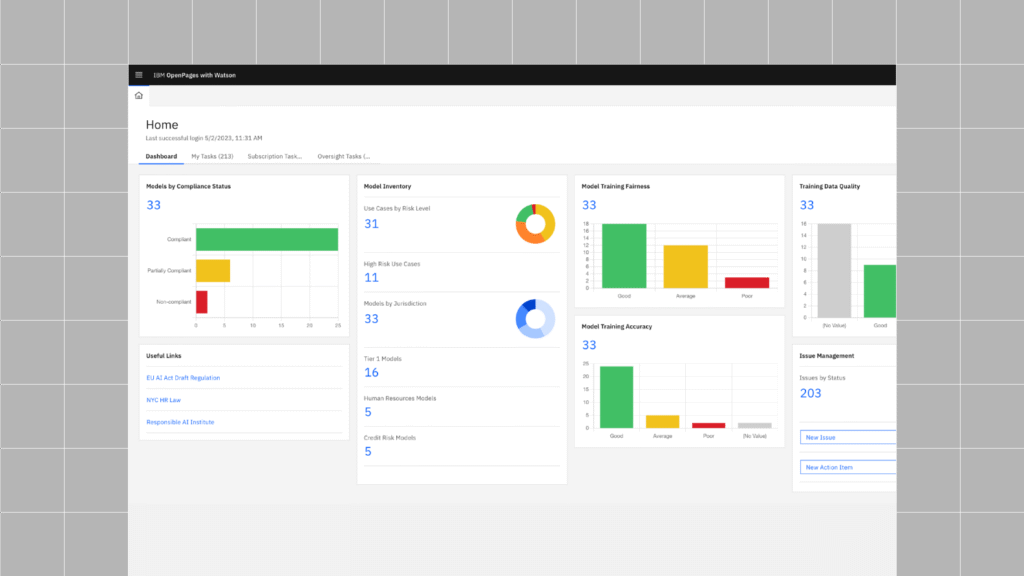
Key capabilities include:
- Automated threat detection – Specifically designed for AI environments with red teaming capabilities
- Custom security policies – Analyzes both input and output prompts for security concerns
- Comprehensive compliance – Supports twelve frameworks including the EU AI Act and ISO 42001
- Multi-scenario coverage – Handles internally developed models, third-party solutions, and embedded systems
The platform works most effectively within IBM’s technology ecosystem, making it ideal for organizations already invested in IBM infrastructure or requiring enterprise-grade security integration.
Microsoft Azure AI Governance – Best for Azure-Centric Organizations
Microsoft Azure AI platform governance provides cloud-native AI risk management addressing enterprise CISO challenges. The platform offers governance recommendations for organizations using Azure AI platform-as-a-service solutions.
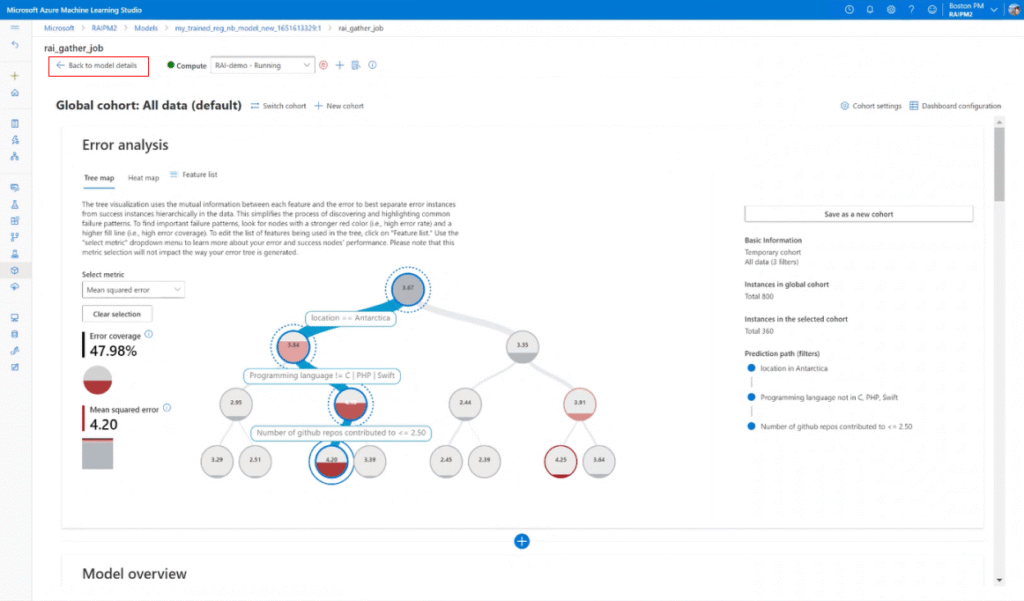
Governance capabilities include:
- Centralized agent visibility – Microsoft Entra Agent ID provides oversight of all AI agents
- Content safety controls – Comprehensive filtering prevents harmful content generation
- Model grounding techniques – Controls AI outputs through system messages
- Risk detection integration – Defender for Cloud identifies and assesses AI workload risks
The platform excels for organizations operating primarily within the Azure ecosystem and requiring seamless integration with existing Microsoft infrastructure.
AWS AI Governance and Risk Management – Best for Cloud-Native Scalability
Amazon Web Services provides comprehensive AI governance tools supporting complex enterprise AI implementations within cloud environments. The AWS approach addresses the full AI lifecycle while integrating with existing AWS security and compliance services.

AWS governance components include:
- Amazon SageMaker Model Cards – Standardized documentation for machine learning models
- Amazon SageMaker Clarify – Detects bias in datasets and models while supporting explainability
- Amazon Bedrock Guardrails – Safety filtering for generative AI applications
- Comprehensive audit logging – AWS CloudTrail and AWS Config provide detailed activity tracking
The platform provides optimal value for organizations heavily invested in AWS infrastructure and requiring scalable, cloud-native governance capabilities.
ModelOp Center – Best for Multi-Cloud and Vendor-Neutral Environments
ModelOp Center specializes in enterprise AI governance across diverse technology environments. The platform covers generative AI, Large Language Models, in-house systems, third-party solutions, and embedded AI without constraining innovation.
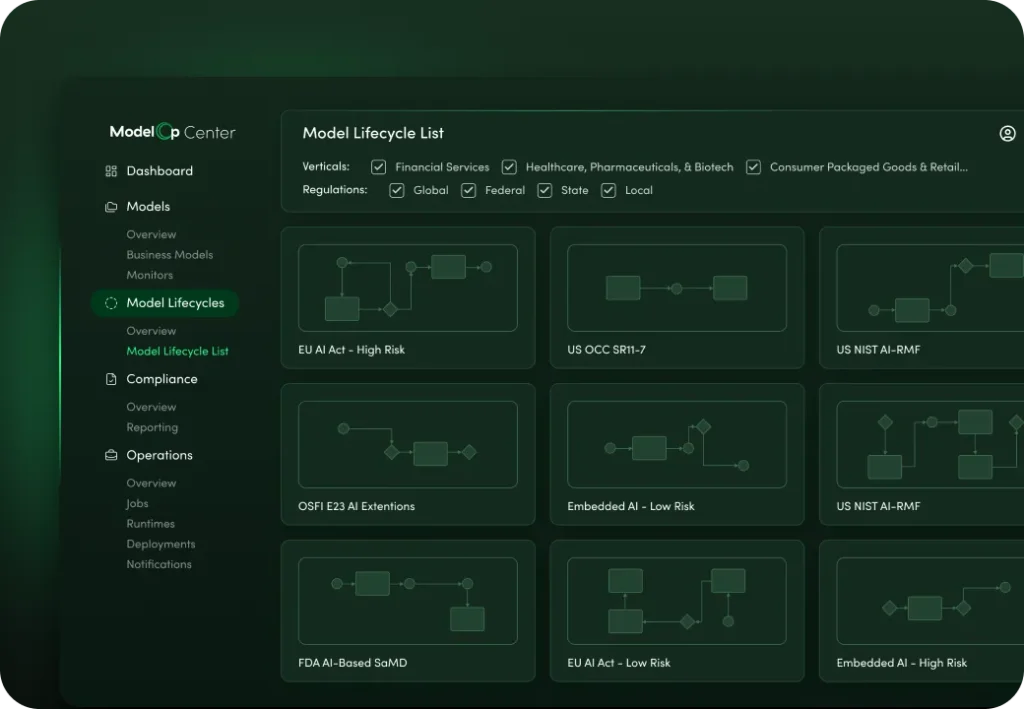
Core platform capabilities:
- Comprehensive AI inventory – Captures detailed metadata about all AI models
- Enforceable compliance automation – Mitigates risks while enabling rapid production deployment
- Workflow automation – Provides consistent controls across model lifecycles
- Embedded AI governance – Manages SaaS and vendor software with embedded AI functionality
ModelOp’s vendor-neutral approach provides optimal flexibility for organizations operating multi-cloud environments or requiring governance across diverse technology stacks.
TrustArc AI Risk Management – Best for Privacy-Focused Compliance
TrustArc addresses the intersection of AI governance, privacy compliance, and regulatory requirements across global jurisdictions. The platform recognizes that managing AI risk alongside multiple privacy regulations creates significant complexity for enterprise governance programs.
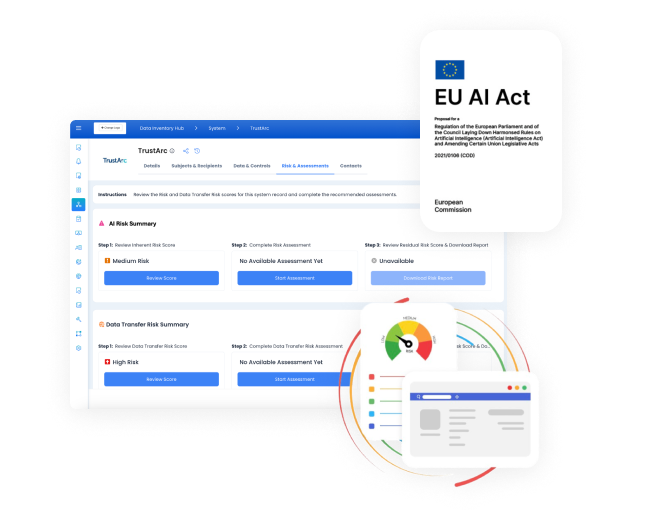
Platform features include:
- Automated risk scoring – Leverages prebuilt templates and data mapping
- Real-time compliance monitoring – Provides continuous visibility into compliance status
- Certification capabilities – Enables demonstration of responsible AI practices
- NymityAI co-pilot – AI-powered regulatory assistance
TrustArc excels for organizations prioritizing privacy compliance and ethical AI implementation, particularly those operating across multiple regulatory jurisdictions.
Key Features to Look for in AI Governance Platforms
Risk Management and Bias Detection
Effective platforms implement comprehensive risk identification and bias mitigation throughout the AI lifecycle. Essential tools include automated bias scanning that continuously monitors model outputs, anomaly detection systems identifying unusual behavior, and statistical fairness analysis evaluating performance across demographic groups.
Compliance Automation and Audit Reporting
Platforms require robust capabilities for automating compliance processes and generating comprehensive audit reports. Audit trails provide legal accountability by documenting AI system activities, configuration changes, and access patterns.
Advanced compliance automation includes policy template libraries based on established frameworks, automated assessment workflows, and real-time monitoring detecting potential violations.
Integration with Enterprise Technology
Modern platforms integrate seamlessly with existing enterprise technology infrastructures including data platforms, security tools, and cloud environments. Critical capabilities include API connectivity with existing systems, standard authentication protocols, and SIEM system integration.
AI Agent and Generative AI Governance
AI agents and generative AI systems create governance challenges requiring specialized capabilities. These include content filtering and safety controls, prompt injection attack detection, output monitoring for inappropriate content, and autonomous behavior tracking with control mechanisms.
Strategic Steps to Select the Right AI Governance Tool
Assess Organizational AI Maturity and Needs
Organizations require comprehensive assessments of current AI landscapes including formal projects, shadow AI implementations, and embedded AI capabilities. The assessment identifies existing governance processes, compliance requirements, and stakeholder needs.
Evaluate Compliance and Regulatory Coverage
Organizations must prioritize governance tools based on specific regulatory environments, industry requirements, and geographic operation scope. Key considerations include mapping relevant regulations to AI use cases and assessing tool capabilities for supporting multiple compliance frameworks.
Consider Integration and Technical Architecture
Technical integration requirements require thorough evaluation ensuring governance tools operate effectively within existing enterprise architectures. Integration assessment includes compatibility with existing cloud platforms, API availability, and security protocol support.
Plan for Scalability and Long-Term Support
Governance tool selection must consider long-term organizational needs including projected AI deployment growth, evolving regulatory requirements, and technical architecture changes.
How Northwest AI Consulting Can Help with AI Governance
Northwest AI Consulting specializes in helping organizations develop and implement comprehensive AI governance strategies balancing innovation enablement with risk management and compliance requirements. The education-first approach ensures teams develop knowledge and skills for effective long-term AI governance management.
Services include comprehensive AI governance assessments, customized governance strategy development, hands-on implementation support, and comprehensive training programs building organizational AI governance competency.
Frequently Asked Questions About AI Governance Tools
Which AI governance tools work best for healthcare organizations with HIPAA requirements?
TrustArc AI Risk Management and IBM watsonx governance provide the strongest capabilities for healthcare organizations requiring HIPAA compliance. Both platforms offer specialized privacy controls, audit trail generation, and regulatory compliance validation specifically addressing healthcare data protection requirements.
How do AI governance platforms handle compliance across multiple countries with different AI regulations?
Leading platforms like TrustArc and ModelOp Center provide multi-jurisdictional compliance support through automated regulatory intelligence, customizable policy frameworks, and region-specific compliance validation. These platforms automatically update compliance requirements as new regulations emerge across different countries.
What is the typical implementation timeline for enterprise AI governance platforms?
Most enterprise implementations complete within 90 days to 6 months depending on organizational complexity and existing infrastructure. ModelOp Center offers the fastest deployment at approximately 90 days, while more comprehensive implementations involving multiple cloud environments may require 4-6 months for full deployment.
Can small companies with limited AI deployments benefit from enterprise governance tools?
Many governance platforms offer tiered pricing and scaled-down versions suitable for smaller organizations. TrustArc and cloud-native solutions like Azure AI Governance provide entry-level options that scale with organizational growth and AI adoption.
How do governance platforms detect and prevent AI model bias in hiring and lending decisions?
Advanced platforms use statistical fairness analysis, demographic parity assessment, and automated bias scanning to identify discriminatory patterns. Tools like Amazon SageMaker Clarify and IBM watsonx governance provide specialized bias detection for high-risk applications including hiring, lending, and criminal justice decisions.
References
- National Institute of Standards and Technology. “AI Risk Management Framework (AI RMF 1.0).” U.S. Department of Commerce.
- Knostic AI. “14 Best AI Governance Platforms and Tools in 2025.” Knostic AI Blog.
- International Organization for Standardization. “ISO/IEC 42001:2023 Information Technology — Artificial Intelligence — Management System.” ISO.
- European Commission. “Artificial Intelligence Act.” Official Journal of the European Union.


